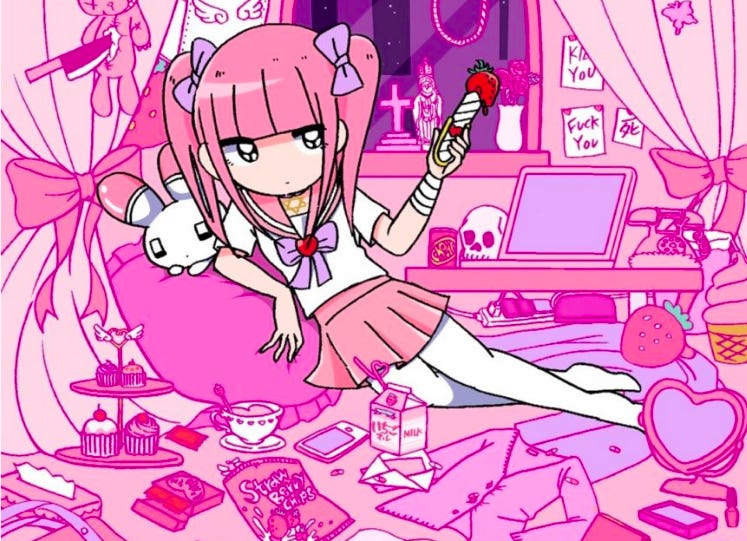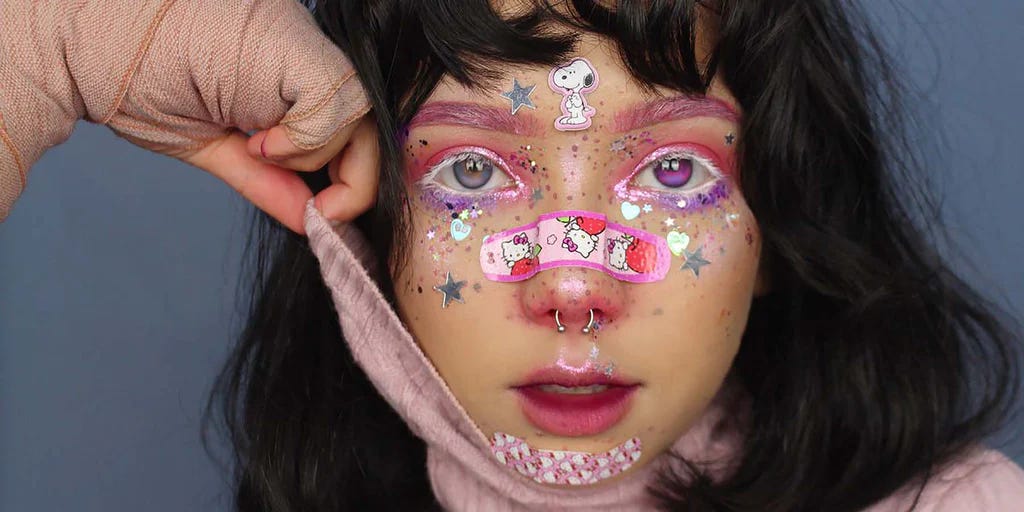Yami Kawaii: Where “Sick” Meets “Sweet”
Japan’s Alternative Fashion Movement to Destigmatize Mental Illness
Trigger Warning: The following article heavily discusses mental illness, especially depression, suicide, and hate crimes against disabled people. Please read at your own discretion.
“Abroad, people see mental illness and depression as being the same as an injury. In Japan, they see a troubled person needing reprieve, and take it as a sign of weakness.”
– Bisuko Ezaki (Yami Kawaii influencer and fashion designer)
Japan has one of the highest suicide rates in the world. Even talking about mental illness is considered taboo. However, unwillingness to open up about mental health is not rooted in ignorance—It is interlinked with fear.

Between 1949 and 1996, the Japanese government carried out tens of thousands of sterilizations, many of which were performed on physically or cognitively disabled individuals. Their intention was to purge their future society of “inferior descendants.” In 1951, the Japanese government claimed that people with “mental disorders” cost Japan ¥100 billion annually in what they referred to as “lost productivity.” Since the families of disabled people prioritized their care over employment, people with mental illnesses were reduced to mere liabilities due to a perceived “inability to contribute.” Reparations and apologies were issued in 2019 by Prime Minister Shinzo Abe, but the extent of the damage goes far beyond these acts alone.
In July 2016, nineteen residents of a facility for disabled people in Sagamihara were murdered. The suspect, Satoshi Uematsu, who was an employee at the facility, said that his actions were a “mercy killing” intended to eliminate disabled people from the world.

Aside from the deaths themselves, another tragic part of this massacre was the fact that none of the murder victims were named. According to The Mainichi, one of the major newspapers in Japan, the police decided not to name the victims at the request of the families. It was presumed that the families of the victims did not want the public to be aware that their loved ones were disabled. One person had even told the newsletter that they believed a friend of theirs might be a victim, but they could not find out due to the names not being publicized.
Yoshihiro Ishihara, a Japanese prisoner of war after World War II, once wrote that “the most terrifying thing about genocide is the facelessness of the individual victims.” By not revealing the victims’ identities, the existence of these people has been denied.Unfortunately, that single tragedy was not the only case in which disabled and/or mentally ill people were denied their right to exist.
In January 2018, a couple of Neyagawa were arrested for enclosing their own daughter in a tiny room and deliberately neglecting her needs for at least fifteen years.
Why?
She was schizophrenic.
The public image of the woman was reduced to media coverage that reinforced negative portrayals of schizophrenia. Some accounts repeatedly referred to the condition using the terms “disorder” and “violent,” with no regard to the fact that schizophrenia is closely related to the individual’s emotional circumstances and environment.
Various newspapers said that her parents had locked her up because they “didn’t want the neighbors to know” about her, or that she even existed. According to journalist and mental health specialist Tatsuya Hikichi, the intention of these reports was to implicitly make readers sympathize with the parents’ actions.
Media manipulation is rooted in the collective’s need to control the narrative, in order to keep the audience believing what they believe. However, sometimes those seeking to take back control of their community’s narrative come from the unlikeliest of places. In this case, you may find some of the most devout survivors and advocates championing mental health awareness where it cannot be ignored: in the bustling streets of Harajuku—the fashion capital of Tokyo.
Yami Kawaii: Harajuku’s Micro-Subculture Embracing Mental Health
“Yami Kawaii is fashion, but it’s also a coping mechanism for complex emotions… Talking openly about painful experiences feels better than keeping it in. When you talk, powerful things can happen.”
– Connie Wang (Executive Editor at Refinery29)

“Yami Kawaii (病み可愛い),” which essentially translates to dark-cute and/or sick-cute, is a Harajuku subculture that combines dark, often morbid themes with bright and sweet imagery. This micro-subculture is an offshoot of the ubiquitous “kawaii” aesthetic, and popularly manifests through accessories like syringes, bandages, and pills alongside ruffles and pretty fonts.

A major component of Yami Kawaii is the visual duality between its dark and cutesy characteristics. I was really fascinated by this in particular because of all the possible interpretations. One might find the juxtaposition as a representation of the emotional back-and-forth of certain mental illnesses. From another standpoint, it could be interpreted that someone can appear bright and happy, but actually be suffering if you look close enough. It can even be as simple as the two themes coexisting without contradicting one another instead working together as one.

“Having this ‘sick’ element inside all the cute - I love the duality… The mismatch between how cute it looks, and the antisocial words is what makes it so popular. That’s what makes it Yami Kawaii. I think there’s a demand for the things people are avoiding.”
– Bisuko Ezaki (Yami Kawaii influencer and fashion designer)
To some, this style may appear to romanticize mental illness in unhealthy ways. It might seem counterproductive. However, in a society that is so hush-hush about mental illness and suicide, it may actually be empowering to display one’s pain for everyone to see. It is their way of actively challenging the silence. Their way of shouting, “I am here. You can’t ignore me.”

“[Kawaii] is simply a pure, happy feeling of cuteness… when you express kawaii, you’re expressing a desire to appeal to other people, to get closer to other people, and expressing a desire for healing. So maybe that can help people with those dark, and more difficult issues that can’t be openly expressed in Japanese society.”
– Joshua Paul Dale (Professor, Kawaii Culture Expert)
Want to learn more? Check out this episode of Style Out There by Refinery29 where Executive Editor and host Connie Wang goes even deeper into the Yami Kawaii subculture!
You can also follow Yami Kawaii pioneers Bisuko Ezaki (@bisukoezaki) and Kuua Oyasumi (@kuua_oyasumi) on Instagram!
If you liked what you read, be sure to subscribe above and follow us on Twitter and Instagram @invisibleasians to stay updated on Politically Invisible Asians!



